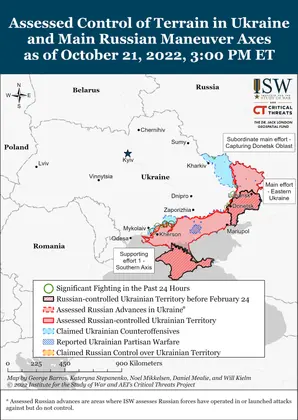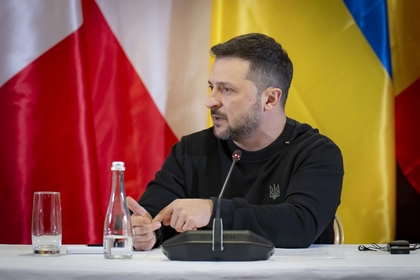Key Takeaways
- The Russian withdrawal from western Kherson Oblast has begun. Russian forces likely intend to continue that withdrawal over the next several weeks but may struggle to withdraw in good order if Ukrainian forces choose to attack.
- Russian President Vladimir Putin is demonstrably setting conditions for Russia to continue a protracted war in Ukraine, not for a negotiated settlement or offramp.
- Russian forces will likely attempt to blow up the dam at the Kakhovka Hydroelectric Power Plant (HPP) to cover their withdrawal from Kherson City and to prevent Ukrainian forces from pursuing Russian forces deeper into Kherson Oblast.
- Russian President Vladimir Putin signed a decree on October 21 creating a Russian government “coordination council” to improve wartime federal coordination.
- Russian and Ukrainian sources reported fighting northeast of Kharkiv City along the international border, on the Svatove-Kreminna frontline, and west of Lysychansk.
- Ukrainian military officials offered a limited overview of the situation on the frontline.
- Ukraine’s Southern Operational Command emphasized that Russian forces are using Ukrainian civilians as human shields when transporting military equipment across the Dnipro River, while Russian sources released footage showing a line of civilians awaiting the ferry from Kherson City.
- Russian forces continued ground attacks in Donetsk Oblast and routine fire west of Hulyaipole and in Mykolaiv Oblast.
- Russian authorities are attempting to maintain the façade of sustainable and strong logistics in southern Ukraine while accelerating measures to compensate for the Kerch Strait Bridge attack.
- Fissures between regional Russian officials, the Russian Ministry of Defense (MoD) and military commissariats, and the Russian civilian population from which mobilization draws will likely intensify in the coming months.
- Russian authorities are preventing Ukrainians in Russia from leaving Russia with complex residency and permit requirements to cross international borders.
- Russian occupation authorities continued the mass forced removal of civilians from the west bank of the Dnipro River under the guise of civilian “evacuations.”
The Russian withdrawal from western Kherson Oblast has begun. Russian forces likely intend to continue that withdrawal over the next several weeks but may struggle to withdraw in good order if Ukrainian forces choose to attack. Ukraine’s Southern Operational Command stated on October 21 that Russian forces are “quite actively” transferring ammunition, military equipment, and some unspecified units from the Dnipro River’s west bank to the east bank via ferries.[1] The Southern Operational Command added that Russian forces deployed 2,000 mobilized men to hold the frontlines and are continuing to shell Ukrainian positions, likely in an effort to cover their withdrawal.[2] Ukrainian military officials reported that the Russian occupation administration is preparing the evacuation of imported Russian specialists, Ukrainian collaborators, and Kherson’s banking system.[3] Russian occupation administration in Beryslav and humanitarian facilities in Kherson City also reportedly ceased operations.[4]
JOIN US ON TELEGRAM
Follow our coverage of the war on the @Kyivpost_official.
The Russian withdrawal from western Kherson requires that a Russian detachment left in contact hold the line against Ukrainian attack, covering other Russian forces as they withdraw. Such a detachment must be well-trained, professional, and prepared to die for its compatriots to effectively perform that duty. The deputy chief of the Main Operational Department of the Ukrainian General Staff, Brigadier General Oleksiy Hromov, assessed on October 20 that Russian military leadership may withdraw “the most combat-capable units” from the left-bank part of the region to the right bank of the Dnipro river and leave mobilized soldiers in contact to cover the withdrawal.[5] Russian milbloggers seized on Hromov’s assessment on October 21 and claimed that Ukrainian officials falsely said that elite units like the VDV and marines are being replaced by untrained mobilized men in Kherson.[6] If Hromov’s assessment is correct, then Russian forces would be setting conditions for a Russian withdrawal to become a rout. Russia’s poorly trained, newly mobilized reservists are very unlikely to stand and resist a Ukrainian counterattack if Ukrainian forces chose to attack them and chase the withdrawing forces. The collapse of a mobilized reservist detachment left in contact would likely lead to a Ukrainian rout of Russian forces on the same scale as Ukraine’s rout of Russian forces in Kharkiv.

N. Korean Troops Massed in Russia to Enter Ukraine War ’Soon’: Pentagon Chief
Russian officials have remained cagey about whether or not Russian President Vladimir Putin has ordered a withdrawal from Kherson and are likely continuing to prepare the information space for such a collapse, as ISW has previously assessed.[7] Kremlin Spokesperson Dmitry Peskov dodged a direct question from reporters addressing the likely withdrawal and directed reporters to the Ministry of Defense on October 21.[8] One Russian milblogger noted on October 21 that Russian forces “will receive bad news from Kherson Oblast” in the coming week and that “November will be very, very hard.”[9] A Russian war correspondent told Russian state-controlled television on October 19 that Ukrainian forces outnumber Russian forces by four to one and that “there will be no good news in the next two months, that’s for sure … severe territorial losses are likely in these two months, but defeat in one battle does not mean losing the war.”[10]
Russian forces will likely attempt to blow up the dam at the Kakhovka Hydroelectric Power Plant (HPP) to cover their withdrawal and to prevent Ukrainian forces from pursuing Russian forces deeper into Kherson Oblast. Russian forces will almost certainly blame Ukraine for the dam attack, as ISW has previously assessed.[11] Ukraine has no material interest in blowing the dam, which could flood 80 Ukrainian cities and displace hundreds of thousands of people while damaging Ukraine’s already-tenuous electricity supply. Russia, however, has every reason to attempt to provide cover to its retreating forces and to widen the Dnipro River, which Ukrainian forces would need to cross to continue their counteroffensive. Any claims that Russian forces would not blow the dam due to concerns for the water supply to Crimea are absurd. Crimea survived without access to the canal flowing from the Dnipro since Russia illegally invaded and annexed it in 2014 through the restoration of access following Russia’s invasion in February 2022. Russian officials have demonstrated their ability to indefinitely supply Crimea with water without access to the canal. Russian forces will try to hold eastern Kherson Oblast not for the water, but rather to provide a buffer zone that enables the defense of Crimea and prevents Ukrainian forces from getting into artillery range of the peninsula. Russian decisionmakers may believe that blowing the dam will enable them to retain that buffer zone. Ukrainian President Volodymyr Zelensky warned on October 21 that blowing the dam could cut water supplies to much of southern Ukraine and would pose a serious risk to the Zaporizhia Nuclear Power Plant (ZNPP), which lies upstream of the dam.[12] The ZNPP relies on water from the Kakhovka reservoir to cool its facilities.
Russian President Vladimir Putin is setting conditions for Russia to continue a protracted high-intensity conventional war in Ukraine, not a negotiated settlement or off-ramp. The information conditions that the Kremlin has set to enable the Kherson withdrawal, the preparations to blow the dam, and the preparations for additional mobilization and conscription all demonstrate that Putin is not seeking offramps in the near term. Instead, he is setting conditions for improved Russian combat capability over the winter and well into 2023. Putin signed a decree on October 21 creating a Russian government “coordination council” to “strengthen coordination of federal executive branch organs and the federal subjects’ executive branch organs” during the war in Ukraine.[13] The council’s responsibilities include coordinating federal and regional authorities to meet the needs of the Russian military; resolving military supply issues, forming plans to supply the military; defining the volume and direction of the Russian state budget to support the military; and creating working groups on select issues, among other things.[14] Putin’s creation of the coordination council is a continuation of Putin’s October 19 declaration of martial law readiness standards, which the Kremlin seeks to use to expand Russian government authorities as way of further transiting Russia to a wartime footing.[15] A prominent Russian milblogger stated that the creation of this council is overdue and that its creation in spring 2022 would have prevented Russia’s logistics and supply problems from becoming so acute.[16] This milblogger stated that Putin’s creation of the council was a “step in the right direction” nonetheless.[17] It is a step that Putin need not take if he were seeking to wrap the war up soon or were looking for some sort of off-ramp or pause that he expected to end major combat operations. The creation of this new coordinating body instead sets conditions for a high level of mobilization of the Russian state, economy, and society for continued high-intensity conventional military operations for the foreseeable future. Putin continues to show his willingness to pay a high price in domestic discontent to pursue a military resolution of the war he initiated on his terms, showing through his actions a marked disinterest in any serious concessions or ceasefire negotiations that could lead to sustainable peace.
See the full report here.
You can also highlight the text and press Ctrl + Enter






